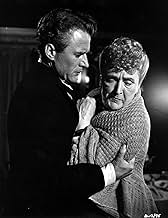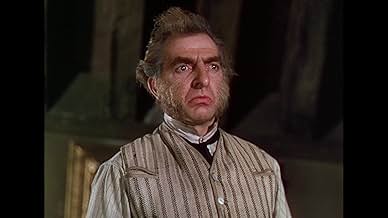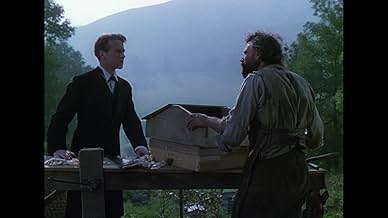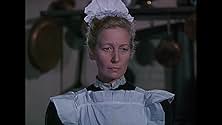CALIFICACIÓN DE IMDb
6.9/10
1.6 k
TU CALIFICACIÓN
Agrega una trama en tu idiomaA beautiful, superstitious, animal-loving Gypsy is hotly desired by a fox-hunting squire even after she marries a clergyman.A beautiful, superstitious, animal-loving Gypsy is hotly desired by a fox-hunting squire even after she marries a clergyman.A beautiful, superstitious, animal-loving Gypsy is hotly desired by a fox-hunting squire even after she marries a clergyman.
- Dirección
- Guionistas
- Elenco
- Premios
- 3 premios ganados y 1 nominación en total
Arthur Mainzer
- Chapel elder
- (as Arthur Reynolds)
- Dirección
- Guionistas
- Todo el elenco y el equipo
- Producción, taquilla y más en IMDbPro
Opiniones destacadas
An unlikely co-production between the British Archers production company, comprising Michael Powell and Emeric Pressburger and dictatorial Hollywood mogul David O Selznick, unsurprisingly starring the latter's wife Jennifer Jones, "Gone To Earth" is a visually remarkable and emotionally turbulent feature. Set in the rugged Shropshire countryside, the action centres around Jones' child of nature Hazel Woodus, only daughter of a semi-idiotic harpist father. Uneducated and wilful, Hazel is a dark haired beauty of wild, gypsy appearance and along with her unusual, instinctive relationship with animals, in particular, a stray fox she has adopted, is obviously set quite apart from the rest of the God-fearing village community where she and father eke out an existence.
Unwittingly causing havoc in the hearts and I dare say loins of almost every young man she meets, the womenfolk in the neighbourhood have Hazel marked down as a man-baiting temptress. Cast out into the street late at night by the Bible-punching mother of another potential suitor, she falls into the path of the brutish and headstrong local squire, David Farrar, who puts her up at his estate for the night, much to the morally-offended chagrin of his attitudinal man-servant Hugh Griffiths.
Later, at a local fair where Hazel sings accompaniment to her father's playing, she comes into the orbit of the new young pastor, Cyril Cusack, who almost immediately falls for her and proposes marriage, which she's bound to accept. However, Hazel has got into the blood of the caddish squire and a tug-of-love ensues over her which in the end, nobody wins.
I sometimes think these wonderful Archers films should come with a warning, "Abandon reality, all who enter here" as the viewer is transported into a stylised version of the everyday world peopled with highly individual, almost preternatural characters. The Thomas Hardy-esque story abounds with hunting and biblical allegories with Hazel identified both as the elusive fox no huntsman can capture let alone tame and also as an unwitting Eve-like stirrer of passions.
Of course it ends in tragedy but not before the Archers customary blend of sweeping narrative, atmospheric music and stunning colour cinematography has created another notable film almost impossible to categorise. Jones speaks a kind of pidgin-English as she immerses herself in her character, although she's probably most effective when not speaking. She doesn't have to, her dark sexuality and wild strangeness bring the menfolk to their knees anyway. Cusack and Farrar make excellent rivals for her in their different ways, the twin benevolent and malevolent influences on either shoulder of Hazel, speaking in her ear.
I'm no fan of hunting and am fully in favour of the fox-hunting ban in this country but I must admit I was carried along in the chase for Hazel's hand in another brilliant Archers production. As a postscript, singer Kate Bush, who in her youth bore a striking resemblance to Jones' appearance in this film, took inspiration from it for her "Hounds of Love" song.
Unwittingly causing havoc in the hearts and I dare say loins of almost every young man she meets, the womenfolk in the neighbourhood have Hazel marked down as a man-baiting temptress. Cast out into the street late at night by the Bible-punching mother of another potential suitor, she falls into the path of the brutish and headstrong local squire, David Farrar, who puts her up at his estate for the night, much to the morally-offended chagrin of his attitudinal man-servant Hugh Griffiths.
Later, at a local fair where Hazel sings accompaniment to her father's playing, she comes into the orbit of the new young pastor, Cyril Cusack, who almost immediately falls for her and proposes marriage, which she's bound to accept. However, Hazel has got into the blood of the caddish squire and a tug-of-love ensues over her which in the end, nobody wins.
I sometimes think these wonderful Archers films should come with a warning, "Abandon reality, all who enter here" as the viewer is transported into a stylised version of the everyday world peopled with highly individual, almost preternatural characters. The Thomas Hardy-esque story abounds with hunting and biblical allegories with Hazel identified both as the elusive fox no huntsman can capture let alone tame and also as an unwitting Eve-like stirrer of passions.
Of course it ends in tragedy but not before the Archers customary blend of sweeping narrative, atmospheric music and stunning colour cinematography has created another notable film almost impossible to categorise. Jones speaks a kind of pidgin-English as she immerses herself in her character, although she's probably most effective when not speaking. She doesn't have to, her dark sexuality and wild strangeness bring the menfolk to their knees anyway. Cusack and Farrar make excellent rivals for her in their different ways, the twin benevolent and malevolent influences on either shoulder of Hazel, speaking in her ear.
I'm no fan of hunting and am fully in favour of the fox-hunting ban in this country but I must admit I was carried along in the chase for Hazel's hand in another brilliant Archers production. As a postscript, singer Kate Bush, who in her youth bore a striking resemblance to Jones' appearance in this film, took inspiration from it for her "Hounds of Love" song.
This was a hard film to see for a very long time, at least in any form that would do it justice. But the small snippets of it I'd caught made me steadfastly wait for the day I could view it, and having done so, I can say it's considerably better than its fairly middling reputation.
Maybe the easiest way to describe it is as Powell & Pressburger's "Wuthering Heights" - it's set in that gothic period drama genre, anyway - but at root it's a grown-up, thoughtful and adult romance-of-sorts set on windswept fairy-tale moors.
The two films it fits closest to in their body of work would be "I Know Where I'm Going" (for the elemental setting) and especially Black Narcissus, for the matchless colour photography and mood of suppressed eroticism bubbling savagely beneath the surface. You can feel the invisible forces of superstition and desire affecting events, the tiny figures swamped by a greater Nature beyond their understanding or powers.
As I've already said, this is a grown-up film, a good 15 years or more before its time in its depiction of adultery and complexity of emotion in a potboiler setting. The sexuality in it is not explicit, but it's firmly engraved in stone between the lines of the script and in small moments of quiet force - flickers of understanding, judgement or confusion passing over every face throughout, speaking volumes.
There's a lurid, hyperreal, almost cartoonishly painterly look to the colour films of the 40s and 50s, which was never seen again afterwards, and is now impossible to recreate. This one has the texture of Singin' In The Rain but is, unusually, set largely outdoors, in the real world, in wide open spaces. Because of this, the nature scenes look, gorgeously, straight out of Bambi.
Gone To Earth is not P&P's greatest film, but it's a real treasure nonetheless. A wild, dark, pagan beauty.
Maybe the easiest way to describe it is as Powell & Pressburger's "Wuthering Heights" - it's set in that gothic period drama genre, anyway - but at root it's a grown-up, thoughtful and adult romance-of-sorts set on windswept fairy-tale moors.
The two films it fits closest to in their body of work would be "I Know Where I'm Going" (for the elemental setting) and especially Black Narcissus, for the matchless colour photography and mood of suppressed eroticism bubbling savagely beneath the surface. You can feel the invisible forces of superstition and desire affecting events, the tiny figures swamped by a greater Nature beyond their understanding or powers.
As I've already said, this is a grown-up film, a good 15 years or more before its time in its depiction of adultery and complexity of emotion in a potboiler setting. The sexuality in it is not explicit, but it's firmly engraved in stone between the lines of the script and in small moments of quiet force - flickers of understanding, judgement or confusion passing over every face throughout, speaking volumes.
There's a lurid, hyperreal, almost cartoonishly painterly look to the colour films of the 40s and 50s, which was never seen again afterwards, and is now impossible to recreate. This one has the texture of Singin' In The Rain but is, unusually, set largely outdoors, in the real world, in wide open spaces. Because of this, the nature scenes look, gorgeously, straight out of Bambi.
Gone To Earth is not P&P's greatest film, but it's a real treasure nonetheless. A wild, dark, pagan beauty.
I now own this title on a DVD since it has recently been issued in the UK in its' new digital, re-mastered version.The colours are certainly impressive.I also visited Much Wenlock, Shropshire recently and photographed us next to the town clock (seen at the beginning of the film) which commemorates Queen Victoria's diamond jubilee in 1897, the year the film is set.
The music of Brain Easdale has a haunting quality and I don't think enough credit has been given to this by other reviewers since it adds immeasurably to the atmosphere of the film.While in Much Wenlock I bought a review of Mary Webb's short stories, including "Gone To Earth" as I always like to read the book from which films are adapted (to see where the film plot diverges).Yes it is rather a corny Victorian melodrama but the acting is convincing enough.I could not help but think there were certain parralls with her (Jennifer Jones) previous epic of "Duel in the Sun" (1946).For Lewton McCanless read Jack Reddin, for Jesse McCanless read Reverend Marston, for Mrs Marston read Senator McCanless etc etc.In both films Jennifer Jones plays a half breed, Native American to Gypsy and is discriminated on accordingly by society.
This film has been hidden from view for too long since its' release in 1950 by the major tv networks and viewers should certainly see this Michael Powell/Emeric Pressburger film if they can, especially if they enjoyed their other films like "Black Narcissus", "The Red Shoes" or "A Matter of Life & Death" from 1946.Technicolour has rarely been put to such good use.I suppose the main reason why you would watch "Gone To Earth" is to see the ravishing Jennifer Jones in the role of Hazel Woodus although all the cast are very effective.If viewers would like to see another example of David Farrar I saw him in "They Met in the Dark (1944) with James Mason and Joyce Howard.
The music of Brain Easdale has a haunting quality and I don't think enough credit has been given to this by other reviewers since it adds immeasurably to the atmosphere of the film.While in Much Wenlock I bought a review of Mary Webb's short stories, including "Gone To Earth" as I always like to read the book from which films are adapted (to see where the film plot diverges).Yes it is rather a corny Victorian melodrama but the acting is convincing enough.I could not help but think there were certain parralls with her (Jennifer Jones) previous epic of "Duel in the Sun" (1946).For Lewton McCanless read Jack Reddin, for Jesse McCanless read Reverend Marston, for Mrs Marston read Senator McCanless etc etc.In both films Jennifer Jones plays a half breed, Native American to Gypsy and is discriminated on accordingly by society.
This film has been hidden from view for too long since its' release in 1950 by the major tv networks and viewers should certainly see this Michael Powell/Emeric Pressburger film if they can, especially if they enjoyed their other films like "Black Narcissus", "The Red Shoes" or "A Matter of Life & Death" from 1946.Technicolour has rarely been put to such good use.I suppose the main reason why you would watch "Gone To Earth" is to see the ravishing Jennifer Jones in the role of Hazel Woodus although all the cast are very effective.If viewers would like to see another example of David Farrar I saw him in "They Met in the Dark (1944) with James Mason and Joyce Howard.
A beautifully made and gently rolling film, almost surreal in content.
Some moments almost seem off cue and through a breathtakingly simple narrative visual style, comes a story of innocence, passion and ultimate tragedy. The music is hypnotic and compliments the flow of the film.
Superb performance by all - including 'Foxy'! If this film was made today it would be showered with Oscars.
Finally, it is hard to see a comparable style in the British film industry prior to this and certainly nothing after it. It is this fact that I believe contributes to the films unique qualities.
Some moments almost seem off cue and through a breathtakingly simple narrative visual style, comes a story of innocence, passion and ultimate tragedy. The music is hypnotic and compliments the flow of the film.
Superb performance by all - including 'Foxy'! If this film was made today it would be showered with Oscars.
Finally, it is hard to see a comparable style in the British film industry prior to this and certainly nothing after it. It is this fact that I believe contributes to the films unique qualities.
I believe I saw this movie perhaps 50 plus years ago, as a young man. It must have been in the mid 1950s or around then. I found Jennifer Jones to be a marvelous actress in this movie and found that to be true in other movies she starred in. But I was overwhelmingly struck with the beauty of the Shrophire countryside which to some extent was almost as much of an attraction to me as Jennifer Jones. I have searched for a long time for this movie...but all I could truly remember of it , with the obvious exception of Miss Jones, was the scream or shout at the end of it ----Gone to Earth. I only know have found out what the meaning of that call was. I will be wanting to purchase this movie soon. Don Berghuis
¿Sabías que…?
- TriviaThe choir was the real choir from the local Methodist chapel. When he heard them singing, director Michael Powell said they were too good and he wanted them to sound "more ragged, like a choir of country folk" only to be told "But we ARE country folk, Mr. Powell."
- ErroresAs Abel and Hazel Woodus come down the hill to the chapel, the mine engine house disappears and then reappears between shots
- Citas
Hazel Woodus: The world wasn't made in seven days only for Abel Woodus.
- Versiones alternativasThe reedited and shortened version titled "The Wild Heart" was produced after a disagreement and court case between director Michael Powell and producer David O. Selznick. Selznick's changes are mainly:- (1) Adding a prologue. (2) Adding scenes explaining things, often by putting labels or inscriptions on them. (3) Adding more close-ups of Jennifer Jones (Selznick's wife). He also deleted a few scenes that he felt weren't dramatic enough. Sadly some of these were major plot points so the story doesn't make as much sense as the original. In his autobiographies, Powell claimed that Selznick only left about 35 mins of the original film. In fact there's a lot more than that. About 2/3 of the original remains.
- ConexionesFeatured in The Late Show: Michael Powell (1992)
Selecciones populares
Inicia sesión para calificar y agrega a la lista de videos para obtener recomendaciones personalizadas
- How long is Gone to Earth?Con tecnología de Alexa
Detalles
- Fecha de lanzamiento
- Países de origen
- Idioma
- También se conoce como
- The Wild Heart
- Locaciones de filmación
- Productoras
- Ver más créditos de la compañía en IMDbPro
- Tiempo de ejecución1 hora 50 minutos
- Color
- Relación de aspecto
- 1.37 : 1
Contribuir a esta página
Sugiere una edición o agrega el contenido que falta

Principales brechas de datos
By what name was Corazón indómito (1950) officially released in India in English?
Responda





























